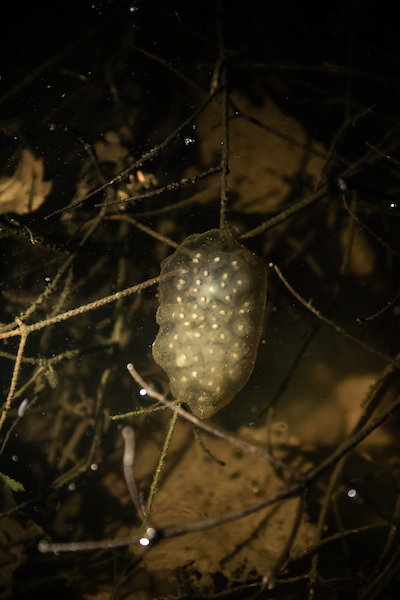By Will Grunewald
Photos by Greta Rybus
From our April 2023 issue
To find one of Greg LeClair’s favorite spots in Waterville, take the I-95 exit for Main Street, pass the access to the Walmart Supercenter, turn into the industrial park across from the big shopping plaza with the Hannaford and the Hobby Lobby, drive by the Marden’s and UPS distribution centers, then park along the shoulder before dead-ending at the Waterville Elks banquet hall. There, amid the sea of asphalt, is a patch of woods, a small wetland, and, from time to time, LeClair’s green Subaru Forester.
A couple of feet of snow were on the ground one day this winter when LeClair was looking toward the woods on one side of the road. Up there, he said, hundreds of amphibians were waiting out the cold, buried under leaf litter and dug into the earth — wood frogs, he noted, can survive even if their bodies more or less freeze solid. In this circumscribed bit of forest, wood frogs are commonly joined by spring peepers and spotted salamanders, plus some blue-spotted salamanders, pickerel frogs, and American toads. Come springtime, on nights when conditions are right — mid-40s, rainy — they rouse from their burrows and head downhill, across the road, to breed in vernal pools and a stream-fed marsh.


Simultaneously, volunteers around the state rouse from their homes, don reflective vests, and head out into the wet, chill dark, to count amphibians crossing roads. They report their data to Maine Big Night, a citizen-science project that LeClair started in 2018, during his senior year at Unity College, where he was president of the herpetology club. That first year, it was just a small group of professors and students. Now, upwards of 1,000 volunteers track hundreds of sites, helping build a record of how amphibians are faring in Maine.
Worldwide, among vertebrates — a group that comprises amphibians, mammals, reptiles, fish, and birds — amphibians are struggling most. Recent studies estimate as many as half of all amphibian species face extinction, as they’re especially sensitive to chemicals, disease, and shifting climate patterns. The situation for the 17 species native to Maine isn’t as bleak, although the Department of Inland Fisheries & Wildlife has labeled the northern leopard frog and LeClair’s personal favorite, the pinkish-orange, cold-water-loving northern spring salamander, species of special concern.
Habitat loss, especially in cities and suburbs, is a persistent threat to amphibians. “In South Portland, we have a site where we’ve identified a wood-frog population that might just have five individuals left,” LeClair says. “There’s just a tiny pool with a few trees around.” The other major threat is cars. Big Night data indicates that about one of every three amphibians crossing a road gets run over.
In the industrial park in Waterville, the woods on either side of the road are for sale as commercial lots. Traffic is usually light, at least, but not always — the Elks host bingo nights and other social functions. “I’ve had nights out here when they’re having a big event, and those are not fun nights,” LeClair says. “Watching salamanders get hit, watching frogs get hit, it’s gruesome.”


Big Night volunteers can’t safely (or legally) stop traffic, but LeClair recruited an advisory committee of herpetologists, GIS specialists, animal behaviorists, and conservation biologists to look at other ways of aiding migration. Recently, they gave the Maine Department of Transportation a list of locations where culvert-like passages could keep amphibians off the road. “I think those tunnels would be the most exciting thing for our volunteers,” LeClair says. “Like, your data just made a permanent conservation difference.”
Of course, when he’s traveling to and from crossing sites, he’s a threat to amphibians too. “I’ll have people in the car with me who have never done this before,” he says, “and I’ll be swerving everywhere. ‘That was a spotted salamander! There’s a blue-spotted!’ I’m so keyed in to what’s on the road. The amount of swerving I do is probably pretty dangerous.”




